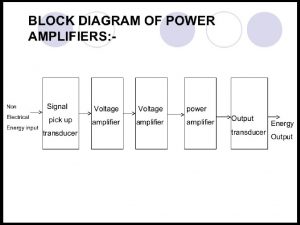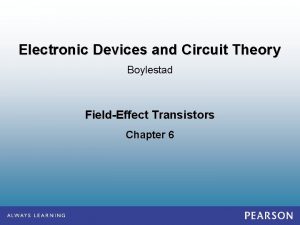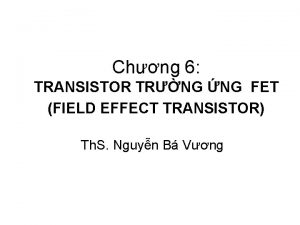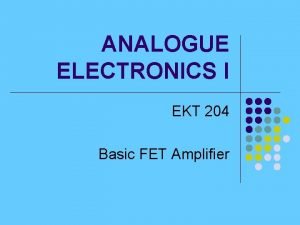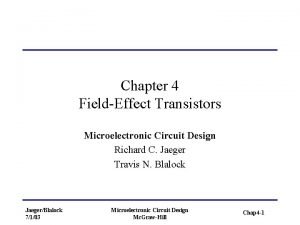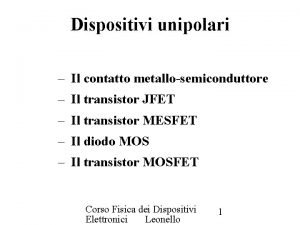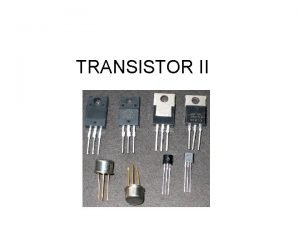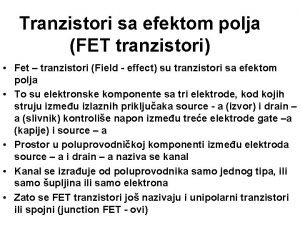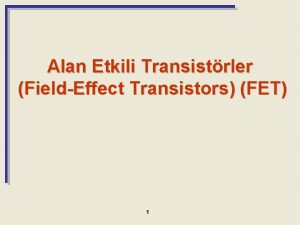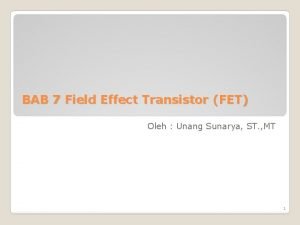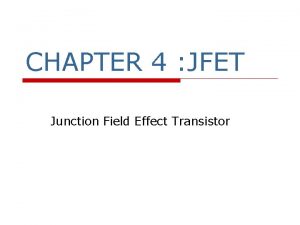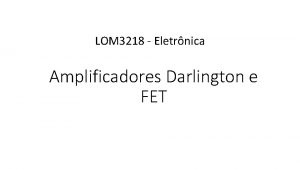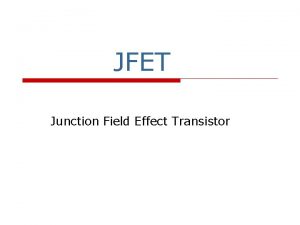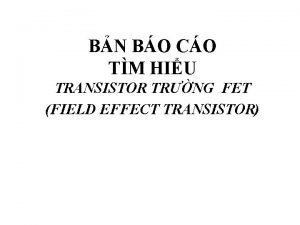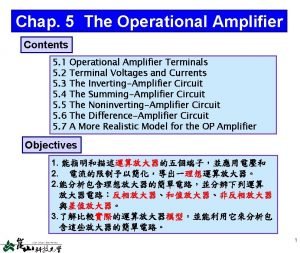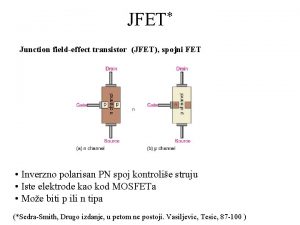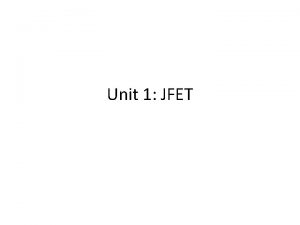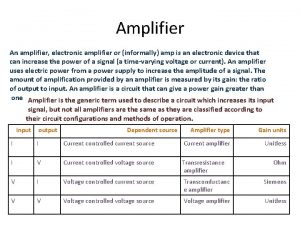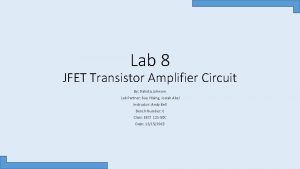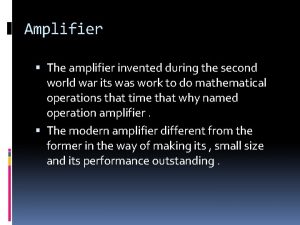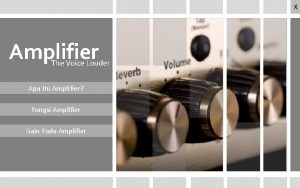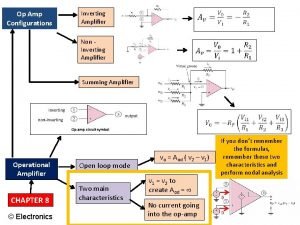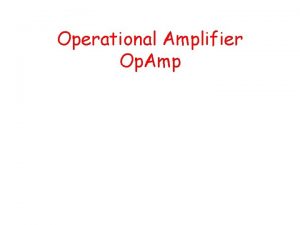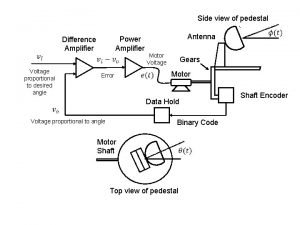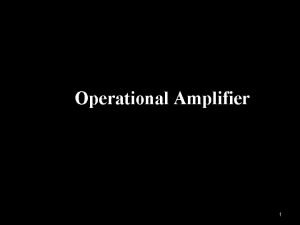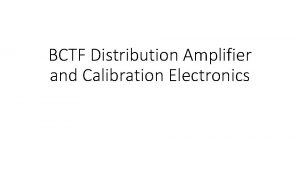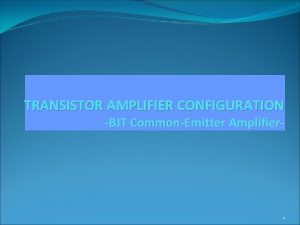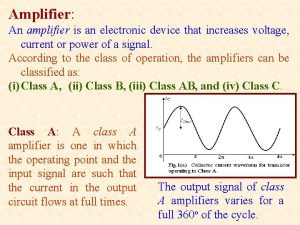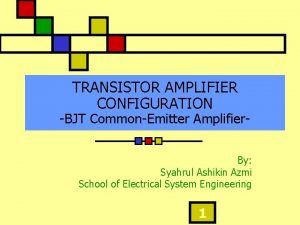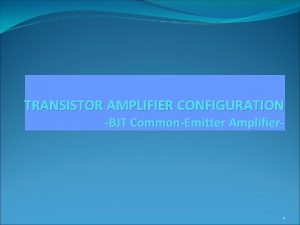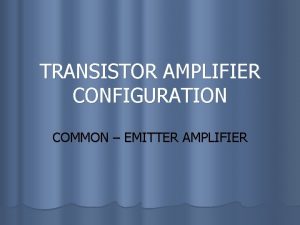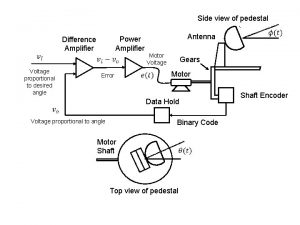JFET AS AN AMPLIFIER JFET AMPLIFIER JFET amplifier




























- Slides: 28

JFET AS AN AMPLIFIER

JFET AMPLIFIER • JFET amplifier circuit • common Source JFET Amplifier uses junction field effect transistors as its main active device offering high input impedance characteristics. Transistor amplifier circuits such as the common emitter amplifier are made using Bipolar Transistors, but small signal amplifiers can also be made using Field Effect Transistors

JFET

Working of JFET • The working procedure of JFET as an amplifier can be easily conceived even if we know a little about vacuum tube. In case of a vacuum tube, we supply the weak input signal between its grid and cathode. This creates a large change in the output obtained at plate circuit. This large change is a desired feature here. This is something which creates an amplifier.

is licensed under CC BY-NC

Working of JFET • The input signal which is weak in magnitude is applied by AC signal source. It is supplied as alternate positive, negative half cycles of AC. When the AC signal is applied to the input circuitry, it will start altering the gate to source voltage.

working • f the reverse voltage falls down, then the width of the depletion region inside the channel will starts decreasing. We have already discussed in our previous article that if the width of the depletion region starts decreasing, then the channel width will be increased. Consequently, the magnitude of charge carriers (Electrons in case of N-channel JFET) flowing from source to drain will increase.

• This will directly contribute to increase in the drain current. The load resistor is connected to the output circuit. The current flowing through it will create a voltage drop, and thus large current will flow through it. This leads to amplification of the signal. And thus JFET as an amplifier is designed.

• Increase in reverse voltage at gate-source terminal • If the AC signal applied at the input terminal will increase the reverse voltage, then the width of the depletion region will start increasing. Due to this, the drain current will starts decreasing. And again the small change in input will cause a large change across the load resistor. This performs the amplification action in JFET

PERFORMANCE PARAMETERS OF JFET AC DRAIN RESISTANCE 1. AC Drain Resistance: The ratio of change in voltage across the drain-source terminal and the change in drain current is termed as AC drain resistance. But the ratio should be considered at a point when the gate-source voltage is kept constant. Its value is in range of 10 kΩ to 1 MΩ. It is also referred as dynamic resistance (rd), it should not be confused with the resistance of channel (RDS), Rds is purely DC while rd is not.

DC DRAIN RESISTANCE 2. DC Drain Resistance: RDS is a symbol used for DC drain resistance. It is the ratio between the change in drain-source voltage and the change in drain current. The value of DC drain resistance is static. Thus it is also termed as static or ohmic resistance.

TRANSCONDUCTANCE 3. Transconductance: It is the ratio between the change in drain current and the change in gate-source voltage but at constant drain-source voltage. It is represented by gm.

AMPLIFICATION FACTOR 4. Amplification factor: The amplification factor is obtained by determining the ratio between the change in drain-source voltage with respect to change in gate-source voltage but keeping the value of drain current constant.

AC DRAIN RESISTANCE X RANSCONDUCTANCE • It is represented by µ. The value of amplification factor can be high as 100

SIGNIFICANCE OF AMPLIFICATION • The Significance of the amplification factor is that it helps to determine the control of gate to source voltage on the value of drain current in comparison to that of the drain to source voltage.

JFET AMPLIFIER • Using JFET as an amplifier • To understand, how a JFET works as an amplifier, first we should be well aware of the fact that how does an amplifier work. It takes an input signal which is weak in magnitude and amplifies it by its internal circuit. The weak signal applied at its input circuit causes a large change in its output circuit.


• Since the N-Channel JFET is a depletion mode device and is normally “ON”, a negative gate voltage with respect to the source is required to modulate or control the drain current. This negative voltage can be provided by biasing from a separate power supply voltage or by a self biasing arrangement as long as a steady current flows through the JFET even when there is no input signal present and Vg maintains a reverse bias of the gate-source pn junction.

Co


• As with the common emitter bipolar circuit, the DC load line for the common source JFET amplifier produces a straight line equation whose gradient is given as: -1/(Rd + Rs) and that it crosses the vertical Id axis at point A equal to Vdd/(Rd + Rs). The other end of the load line crosses the horizontal axis at point B which is equal to the supply voltage, Vdd.

• The actual position of the Q-point on the DC load line is generally positioned at the mid center point of the load line (for class-A operation) and is determined by the mean value of Vg which is biased negatively as the JFET is a depletion-mode device. Like the bipolar common emitter amplifier the output of the Common Source JFET Amplifier is 180 o out of phase with the input signal.

• One of the main disadvantages of using Depletion-mode JFET is that they need to be negatively biased. Should this bias fail for any reason the gate-source voltage may rise and become positive causing an increase in drain current resulting in failure of the drain voltage, Vd.

APPLICATION OF JFET • JFET Amplifier Current and Power Gains • We said previously that the input current, Ig of a common source JFET amplifier is very small because of the extremely high gate impedance, Rg. A common source JFET amplifier therefore has a very good ratio between its input and output impedances and for any amount of output current, IOUT the JFET amplifier will have very high current gain Ai.


This Photo by Unknown Author is licensed under CC BY-SA

CS JFET

THANK YOU
 Jfet amplifiers
Jfet amplifiers Power amplifier and voltage amplifier
Power amplifier and voltage amplifier Boylestad
Boylestad Simbol fet dan mosfet
Simbol fet dan mosfet The constant current region of a jfet lies between
The constant current region of a jfet lies between Jfet và mosfet
Jfet và mosfet Jfet terminals identification
Jfet terminals identification Gm jfet
Gm jfet Self bias jfet
Self bias jfet Jaeger microelectronic circuit design download
Jaeger microelectronic circuit design download Determine id
Determine id Jfet funzionamento
Jfet funzionamento Bjt fet
Bjt fet Jfet ac analysis
Jfet ac analysis Izlazna karakteristika tranzistora
Izlazna karakteristika tranzistora Mosfet çalışma bölgeleri
Mosfet çalışma bölgeleri Mosfet kanal
Mosfet kanal Jfet
Jfet Amplificador darlington
Amplificador darlington Floating gate transistor animation
Floating gate transistor animation Jfet types
Jfet types Power jfet
Power jfet Polarização jfet
Polarização jfet Fet and jfet
Fet and jfet 10 zone amplifier
10 zone amplifier Building a ldmos amplifier
Building a ldmos amplifier Intel vtune amplifier documentation for nurses
Intel vtune amplifier documentation for nurses Hspice ac simulation
Hspice ac simulation Summing amplifier op amp
Summing amplifier op amp

